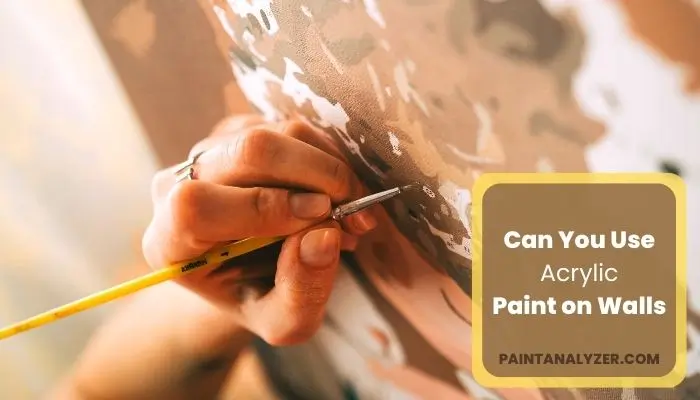Whether you’re looking to add a pop of color or create a mural, painting your walls is a great way to personalize your space. Acrylic paint is a versatile medium that can be used for a variety of applications, including painting walls.
Acrylic paint is a type of synthetic resin-based paint that was first developed in early 1934. It’s known for its durability and versatility, and it can be used on a variety of surfaces including canvas, wood, metal, and glass. Acrylic paint dries quickly and has a high pigment load, which means it can achieve rich colors and strong coverage.
While there are some advantages to using acrylic paint on walls, there are also some potential disadvantages that you should be aware of before beginning a project.

Can acrylic paint be used on walls?
Acrylic paint is a versatile medium that can be used for a variety of applications, including walls. While it is possible to use acrylic paint on walls, there are a few things to keep in mind before doing so.
For starters, acrylic paint is not as durable as other types of paint, so it is more likely to chip or scratch over time. Additionally, acrylic paint can be tricky to apply evenly, so it is important to take your time and use a steady hand when painting with this medium.
If you are planning to use acrylic paint on your walls, it is best to start with a clean, smooth surface. If your walls are not perfectly smooth, you may want to consider sanding them down before painting. Once your walls are prepped and ready to go, you can start painting!
When painting with acrylics, be sure to use a primer beforehand. This will help the paint to adhere to the wall better and will also make the color appear more vibrant. Once you have applied the primer, you can start painting with your chosen color of acrylic paint.
Remember to take your time when painting and to use even strokes. Acrylic paint can dry quickly, so it is important to work in small sections. Once you are finished painting, you can seal the paint with a varnish or sealant to help protect it from wear and tear.
How to Paint wall using Acrylic Paint?
Acrylic paint is an amazing medium that can be used for a variety of painting projects. When painting with acrylics, it is important to understand the different techniques that can be used to achieve the desired effect. Here’s how to paint with acrylics:
Step 1: Prepare the Surface
Start by preparing your surface. Make sure the wall is clean and free of any debris. If you’re painting over the existing paint color, you’ll need to sand the surface first to create a smooth base for the new paint.
Step 2: Select Paint and Colors
Select your paint colors. Acrylic paint comes in a wide range of colors, so take some time to choose the perfect shade for your project.
Step 3: Start Painting
Once you have your colors selected, it’s time to start painting! Begin by applying a thin layer of paint to the surface. Use a brush or roller to apply the paint evenly. For best results, use a brush designed specifically for use with acrylic paint.
Step 4: Use Special Brush For Different Patterns
One of the most basic techniques for painting with acrylics is to simply apply the paint to the surface with a brush. This can be done in a variety of ways, depending on the type of brush being used and the desired effect. For example, if you are looking for a more textured look, you can use a stippling brush to apply the paint in a series of small dots. If you want a more even coverage, you can use a flat brush to apply the paint in even strokes
Acrylic painting Tips for the best result
There are a few things you can do to ensure you get the best results when painting your walls with acrylics.
- Before the beginning, decide whether you want specific design on the wall or just you want to do normal paint on your wall.
- You can either freehand a design or use stencils to create a more uniform look.
- Once you have your design, sketch it out lightly on the wall with a pencil so you have a guideline to follow when painting.
- Choose your colors and pour them into paint trays.
- When using multiple colors, be sure to label the trays so you don’t get them mixed up.
- Begin painting your design with a brush or roller, following your pencil lines as closely as possible.
- If you make any mistakes, simply wait for the paint to dry and then touch up those areas with a different color or some white paint.
- Once you’re finished painting, allow the paint to dry completely before adding any final details or varnishing the piece.
What other Paint Can You Use on the Walls?
There are a variety of paints that can be used on walls, depending on the surface you are painting and the desired finish. For example, if you are painting a new wall made of drywall, you will want to use a different paint than if you are painting an old brick wall. The following is a list of some common types of paint and their uses:
Latex Paint
Latex paint is a water-based paint that is popular for its ease of use and clean-up. It is also very versatile, as it can be used on a variety of surfaces including wood, metal, and drywall.
Oil-based paint
Oil-based paint is another popular choice for walls, as it provides good coverage and durability. However, it can be more difficult to work with than latex paint, and cleanup requires solvents such as mineral spirits.
Enamel Paint
Enamel paint is often used for high-traffic areas or surfaces that need to be washed frequently, such as kitchens and bathrooms. It has good durability and resistance to stains and scratches.
Chalkboard Paint
Chalkboard paint can be fun to use in kids’ rooms or playrooms. It can also be useful in offices or other places where people need to jot down notes or ideas quickly.
Paint the walls of your house with acrylic paint | DIY
Advantages and Disadvantages of Using Acrylic paint on a wall
When it comes to painting your walls, you have a variety of options to choose from. Acrylic paint is one option that has its own set of advantages and disadvantages. Here is a look at some of the pros and cons of using acrylic paint on your walls:
Advantages:
-Acrylic paint dries quickly, so you won’t have to wait long to enjoy your newly painted walls.
-This type of paint is also easy to clean up, so you won’t have to worry about making a mess.
-Acrylic paint is very versatile and can be used to create a variety of looks, from a matte finish to a high-gloss finish.
Disadvantages:
-Acrylic paint can be more expensive than other types of paint.
-This type of paint can also be difficult to work with, so it’s important to read the instructions carefully before getting started.
-Acrylic paint can also be tricky to remove if you ever decide to change the color of your walls.
Is Acrylic Paint Safe to Use on Plaster Surfaces?
When it comes to using acrylic paint on plaster surfaces, safety is a top concern. Thankfully, acrylic paint is generally considered safe for use on plaster. It adheres well to the surface, dries quickly, and provides a durable finish. However, to ensure proper adhesion, it is advisable to prime the plaster before applying acrylic paint. Always follow recommended safety guidelines and proper ventilation when working with paints.
Can You Use Water-Based Acrylic Paint on Walls?
Water-based acrylic paint is a versatile product that can be used for a variety of applications, including walls. It has a number of advantages over other types of paint, including being easier to clean up and having less odor. However, there are also some things to keep in mind when using water-based acrylic paint on walls.
One thing to consider is the type of wall you’re painting. If you’re painting over an existing coat of paint, it’s important to make sure that the surface is properly prepared before applying the new coat. This means making sure that the old paint is sanded down and that any cracks or holes are filled in.
Otherwise, the new coat of paint may not adhere properly and could start peeling off soon after it’s applied. Another thing to keep in mind is that water-based acrylic paint dries quickly. This can be advantageous if you’re trying to get a project done quickly, but it also means that you need to work fast and be careful not to smudge or streak the paint while it’s still wet.
Once it’s dry, however, water-based acrylic paint is very durable and resistant to chips and scratches.

Conclusion
Acrylic paint can be used on walls, the finish of the paint will be very matte and textured. It is not suitable for a flat, glossy or smooth surface. Always follow safety guidelines. It’s best to use water-based acrylic paints, so watch for warnings regarding flammable materials. Water-based paints usually dry quickly, so cleanup is easier.
Sometimes, acrylic paints need to be thinned with a solvent, so be sure to follow the manufacturer’s directions. If you use oil-based acrylic paints, be sure to ventilate the area, as paint fumes can be toxic. This painting technique is often used on wooden panels and ceilings where the surface is already textured.

